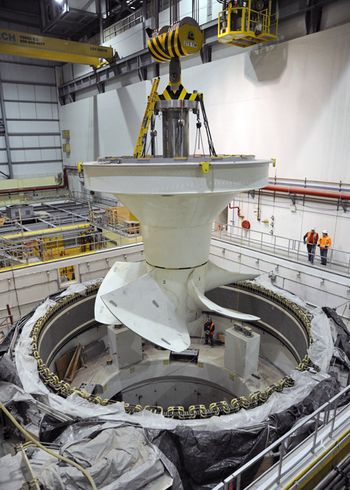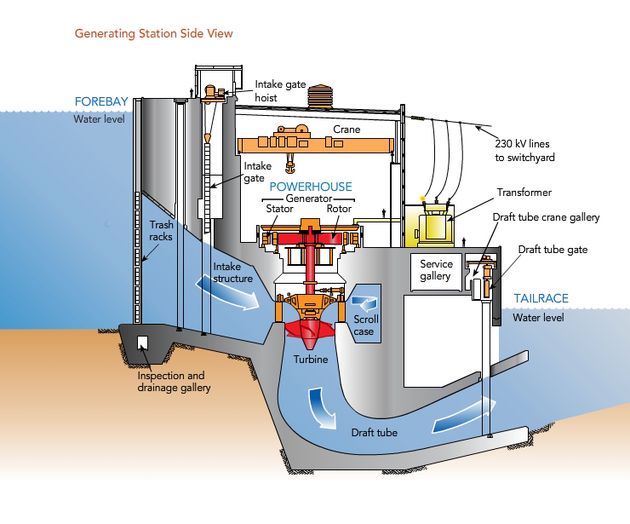Electricity is an essential part of day-to-day life. To see where electricity comes from all we need to do is look inside an aluminum wire. The problem is what we are looking for is too small to see. But, if you could look past the protective covering, past the aluminum wire’s shiny surface, you would see that the wire is made up of tiny particles. These are atoms, the basic building blocks from which everything in the universe is made.

Workers install a giant turbine runner at the Wuskwatim generating station.
Enlarge image: Workers in hard hats lowering a huge turbine into place.
If you could look closely at an atom you would see that the atom itself is made up of even smaller particles. Some of these particles are called electrons. Usually, electrons spin around the centre, or nucleus, of the atom. However, sometimes electrons are knocked out of the outer orbit of an atom. These electrons become “free” electrons.
All materials normally have free electrons that are capable of moving from atom to atom. Some materials, such as metal, contain a great number of free electrons and are called conductors. Conductors are capable of carrying electric current. Other materials, such as wood or rubber, have few free electrons and are called insulators.
If free electrons in a conductor can be made to jump in the same direction at the same time then a stream, or current, of electrons is produced. This is an electric current. In an electrified wire, the free electrons are jumping between atoms, creating an electric current from 1 end to the other. But, how can the electrons jump in the same direction at the same time? By using magnets.
Surrounding the end of every magnet are invisible lines of force called magnetic fields. If you move a straight wire through a magnetic field, the force will push the free electrons from 1 atom to another, creating electric current. If you move several coils of wire quickly and continuously through the field of a powerful magnet, a great quantity of electric current can be produced.
How we produce electricity
We use machines called generators to produce electricity. In a generator, a huge electromagnet, or rotor, is rotated inside a cylinder, called a stator, containing coils and coils of electric wires. Some rotors are 12 metres across and weigh as much as 8 railway cars, nearly 380 tonnes. A great deal of energy is needed to rotate something that size. We use the province’s abundant supply of water.
Electricity generated using waterpower is called hydroelectricity. A hydroelectric generating station uses the natural force of a river as energy. The same water flow or current that pushes a floating canoe down a river can also turn a generator’s rotor.
Typically, there are 2 components to a generating station. A powerhouse that houses the generators and a spillway that allows any water not being used to bypass the powerhouse.
At the heart of a hydroelectric generating station is the turbine runner. Looking like a giant propeller, some turbine runners are nearly 8 metres across. Attached to the rotor by a 5-metre shaft, the turbine runner converts the physical energy of the water into the mechanical energy that drives the generator.
Water flows into a station’s powerhouse through the intake and enters into the scroll case. The scroll case is a spiral area surrounding the turbine. The spiral shape gives the incoming water the spiral movement which pushes the blades of the turbine. As the turbine is turned, the attached rotor also spins, generating electricity. The potential energy of the river is converted into the mechanical energy of a generator which produces electric energy. Just 1 of the 10 generators at the Limestone generating station can produce 133 million watts or 133 megawatts of electricity. That’s enough to supply power to over 12,000 homes.

Cross-section view of the Long Spruce generating station intake and powerhouse.
Enlarge image: Long Spruce generating station intake and powerhouse (cross-section view).
When the natural flow of a river is adequate, a run-of-river plant is built. The run-of-river design reduces the need for a large reservoir of water, or forebay, behind the station. Instead, the water flowing into a generating station upstream is used immediately, not stored for later use. The Limestone generating station located on the Nelson River is an example of a run-of-river design.
When the natural flow of water is inconsistent or inadequate, a more extensive network of dams is constructed to create a large forebay to provide for times when the river’s water level is low. The dam also creates a head of water, or waterfall, to ensure the water has enough force to spin the turbines. The Grand Rapids generating station on the Saskatchewan River is an example of a station that uses a water reservoir.
How electricity is transmitted
When you plug a toaster or a stereo into a wall socket, electricity is instantly there to toast your bread or play music. But have you ever wondered how that electricity gets from a hydroelectric generating station to the socket in your wall? For the answer, we need to take another look at those electrons in our aluminum wire.
Remember, magnets passing over a wire or coil of wire push electrons causing them to jump between atoms. As the electrons jump they transfer a charge to the next atom. As the next atom receives the charge its electron jumps. The magnets trigger a chain reaction which moves down the wire. The electric energy travels down the wire because aluminum is a conductor — it’s conducting the electricity. Manitoba Hydro has an extensive system of wires of varying sizes that conduct electricity throughout the province and to your house. But, that’s only part of the answer.
So, we must transmit the renewable hydroelectric power it generates about 1,000 km to southern Manitoba where most people live and work, and where most businesses are located.
But, electricity doesn’t travel long distances easily. It needs help.
We use high voltage direct current (HVDC) technology to transmit electricity from the north more efficiently. Direct current (DC) is electric current that flows in one direction only. It’s the type of power produced by batteries used in cameras, flashlights and cars. The electricity in your home is alternating current (AC), electric current which reverses direction approximately 60 times a second. The advantage of DC is that the power loss over long distances is considerably less than AC.
A higher voltage is used with DC transmission to increase energy transmission and reduce losses. To explain why, let’s compare electricity flowing through a wire and water flowing through a pipe. Just as great quantities of water can be moved through a large diameter pipe, a great quantity of electricity can be moved through a large diameter wire. Great quantities of water can also be moved through a small diameter pipe, such as a garden hose, by increasing the pressure. Similarly, electricity can be moved in greater quantities through a small diameter wire by increasing the voltage.
We built 3 HVDC transmission lines, known as Bipole I, Bipole II, and Bipole III, to bring electricity from the north. In your home, the electricity you use has 120 volts AC of force. The electricity travelling on the HVDC lines has 500,000 volts or 500 kV of force.
Let’s say the electricity in your house has the same force as a baseball pitched towards you at 100 km per hour. The force of the electricity on the HVDC line would be over 4,000 times more powerful.
Hydroelectric generating stations produce AC electricity that has about 25 kV of force. It must be converted to DC and transmitted at an even higher voltage to reduce the power losses experienced over long distances. This conversion is done at the Henday, Radisson, and Keewatinohk converter stations located near Gillam, Manitoba.
Once the electricity has been converted from AC to DC, it travels south to the Dorsey and Riel converter stations outside Winnipeg. At Dorsey and Riel, the electricity is converted back to AC to be delivered to your home as refrigerators, TVs, computers, and other appliances run on AC electricity. From Dorsey and Riel, AC transmission lines supply other areas of southern Manitoba, plus the northern U.S. states, Saskatchewan, and northwestern Ontario.
The high-voltage AC lines transport the electricity to substations located throughout the province. These substations contain equipment used to transform voltages to lower levels, switch the current in a line on or off, and analyze and measure electricity.
The transformation of electricity from high voltage to low voltage is done using the same principle as generation. The magnetic field of a coil of wire carrying an alternating, or fluctuating current, can cause a fluctuating current in a second coil. In a transformer, 2 separate coils of wire are wrapped around a magnetic iron core. The electricity in the first coil of wire creates a fluctuation in the magnetic field of the iron core. That fluctuation then passes through the iron core, electrifying the second coil of wire. If the second coil of wire has half as many turns the electricity will have half the voltage. If the second coil has twice the number of turns, then the voltage will be doubled.
From the substations, electricity runs through overhead lines or underground cables to transformers which complete the voltage reduction. These transformers are located near the top of hydro poles for overhead lines or at ground level for underground service.
From the pole, electricity travels through a wire into your home, going first to the meter and the main switch. The wires then lead to a distribution panel. From there, circuits inside the walls lead to the power outlets and light fixtures.




